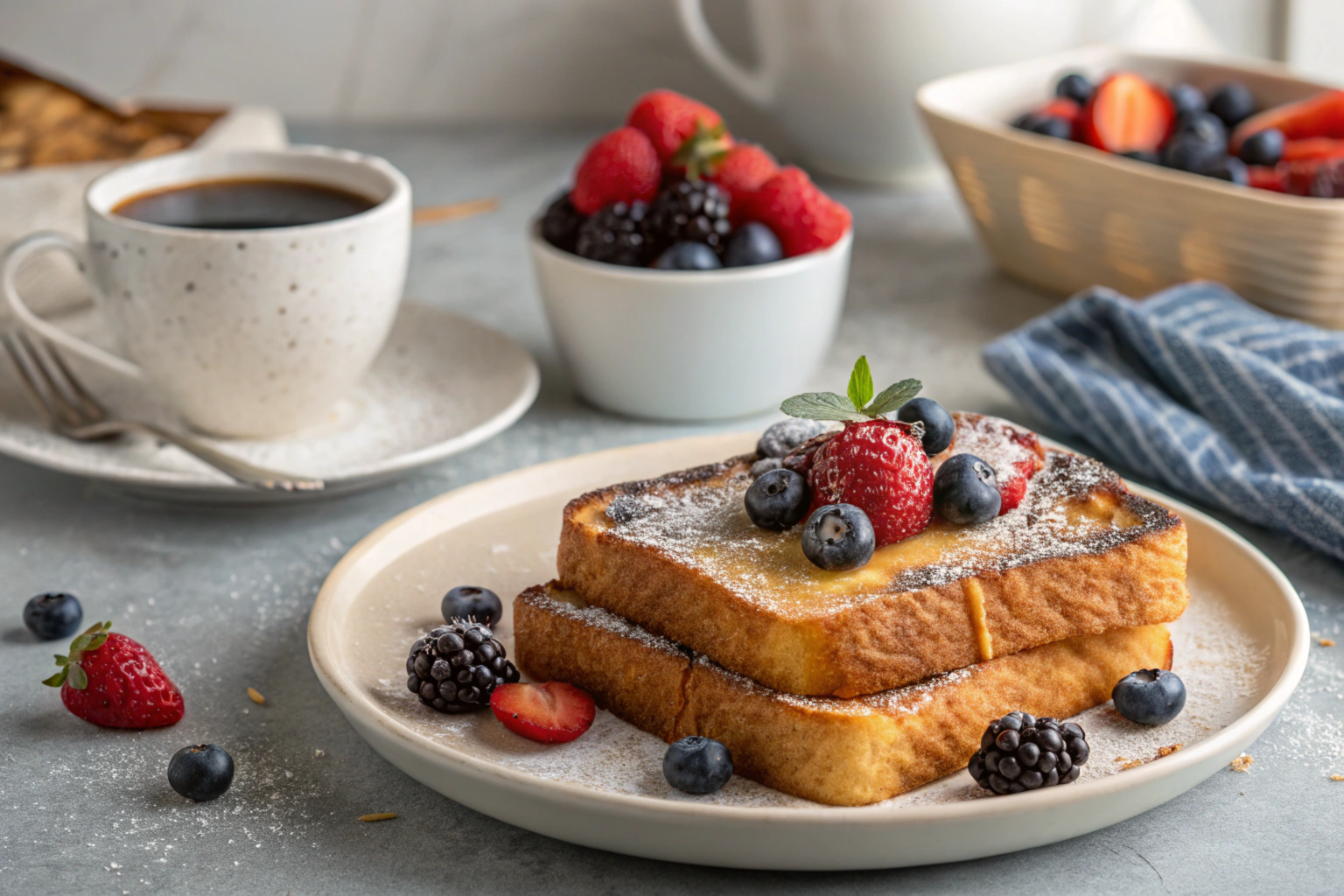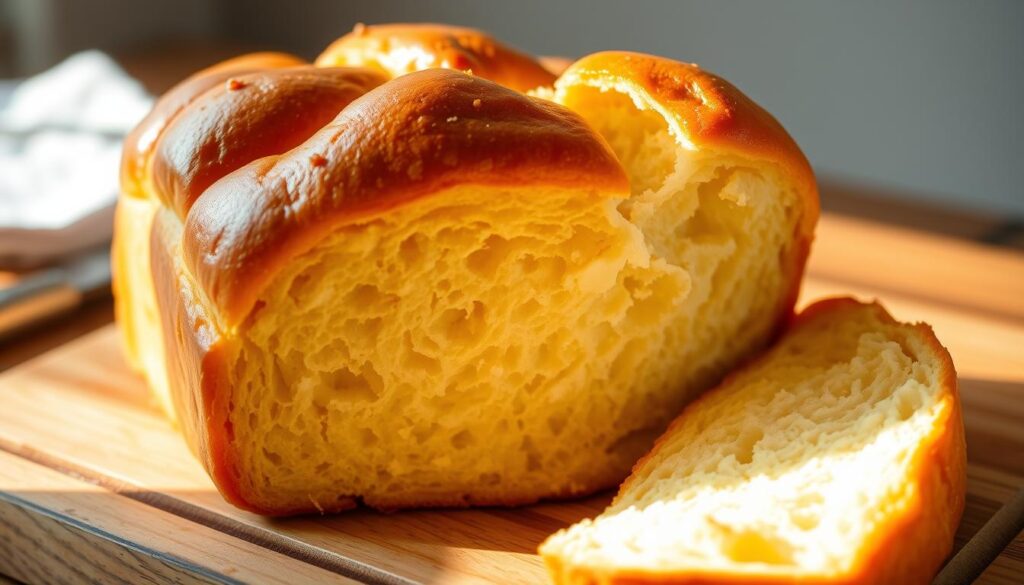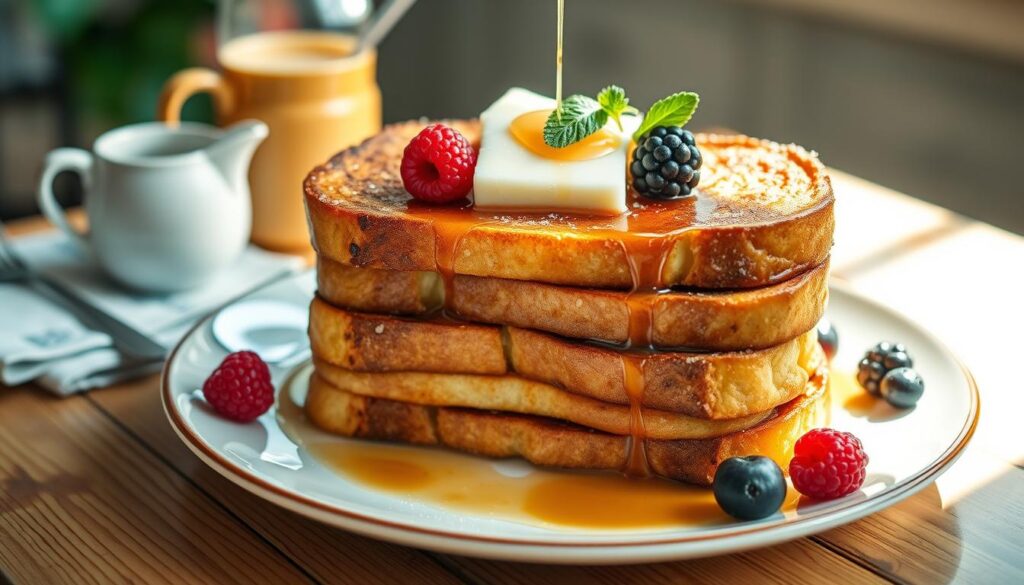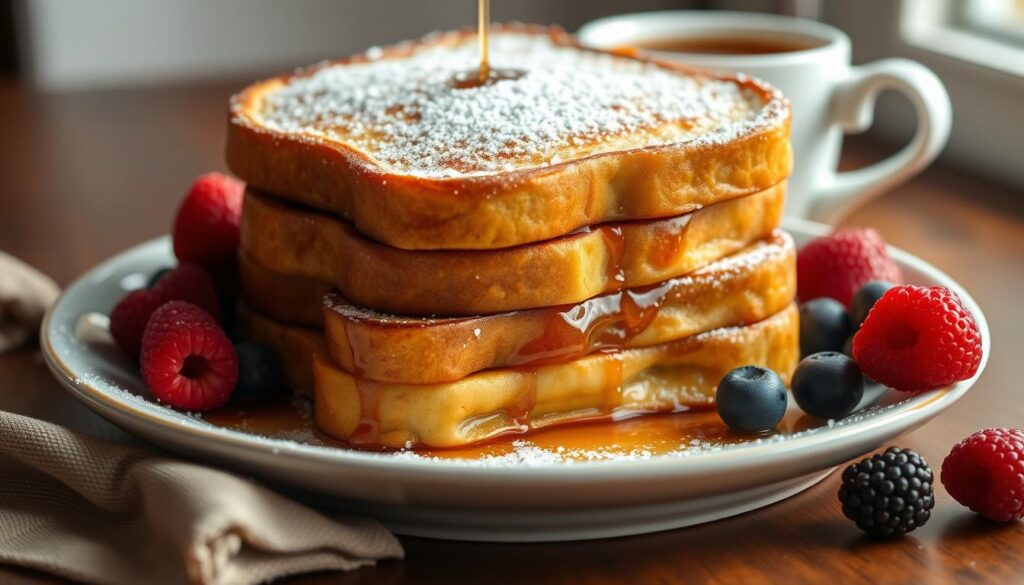The smell of French toast cooking in the kitchen is amazing. It brings back happy memories from our childhood. It’s perfect for a relaxed brunch with family or a quiet morning with your partner.
Picture biting into a slice of French toast. It’s golden on the outside and soft on the inside. The perfect French toast is a mix of crispy edges, a soft middle, and just the right sweetness.
Key Takeaways
- Discover the secrets to achieving the ultimate French toast with a perfectly custard-soaked interior and a golden-brown crust.
- Learn how to choose the best bread and prepare the ideal custard mixture for restaurant-quality results.
- Master essential techniques, from temperature control to butter versus oil, to ensure your French toast is cooked to perfection.
- Explore classic and creative topping ideas to elevate your weekend brunch experience.
- Avoid common mistakes and troubleshoot any issues for a seamless French toast preparation.
What Makes the Ultimate French Toast Special
Making the perfect French toast is more than just soaking bread in custard. It’s about knowing the science and using top-notch ingredients. This makes the French toast truly special.
The Science Behind Perfect Custard Absorption
The secret to great French toast is how well the bread absorbs the custard. This depends on the bread’s texture, the mix of wet and dry ingredients, and the cooking temperature. By getting these right, you get a French toast that’s perfectly custard-soaked.
The Role of Quality Ingredients
Choosing the right ingredients is key for a family favorite French toast. Good milk, eggs, and vanilla make the custard rich and creamy. The bread you pick also matters, with brioche or challah making it richer.
By mastering the science of custard absorption and picking quality ingredients, you can make French toast that’s restaurant-quality. It turns a simple breakfast into a memorable meal.
Essential Ingredients for Restaurant-Quality French Toast
Making the perfect brioche bread French toast at home needs a few key ingredients. These ingredients make the dish as good as a restaurant’s. From the fluffy custard base to the rich toppings, each part is important for a great breakfast.
The heart of great brioche bread French toast is the bread. Choose a rich, fluffy brioche bread that soaks up the custard well. Also, use fresh, high-quality eggs for a creamy texture.
Adding vanilla extract and a pinch of cinnamon to the custard brings out the flavors. These ingredients pair well with the brioche bread, making the dish warm and comforting.
For toppings, a drizzle of real maple syrup and a sprinkle of cinnamon are classics. For something extra, try whipped cream or powdered sugar.
| Ingredient | Purpose |
|---|---|
| Brioche bread | Provides a rich, fluffy base for the French toast |
| Eggs | Contribute to the creamy, custard-like texture |
| Vanilla extract | Enhances the overall flavor profile |
| Cinnamon | Adds a warm, cozy spice note |
| Maple syrup | Provides a sweet, indulgent topping |
| Cinnamon sprinkle | Gives the dish an extra touch of flavor and visual appeal |
With these ingredients, you can make a brioche bread French toast as good as any brunch spot.
Choosing the Best Bread for Your French Toast
The type of bread you pick can really change your French toast game. Many recipes use simple white bread. But, brioche bread is a game-changer.
Why Brioche is the Top Choice
Brioche is a rich, buttery bread that’s perfect for French toast. Its golden brown color and custard-soaked texture make it a treat. The bread’s high egg and butter content soak up the custard, making it custardy inside.
Alternative Bread Options
If brioche isn’t your thing, or you want to try something new, here are some alternatives:
- Challah bread: It’s another egg-based bread that’s custard-like.
- Sourdough bread: Its tangy flavor and sturdy texture pair well with custard.
- Cinnamon swirl bread: It adds a cinnamon flavor to your French toast.
Bread Thickness and Preparation
The thickness and how you prepare your bread also matter. Go for slices that are 1/2 to 3/4 inch thick. This way, they won’t be too soggy or not cooked right. Let the bread soak in the custard for a few minutes before cooking. This ensures it’s full of flavor and texture.
“The secret to the best French toast is in the bread you choose. Brioche is the ultimate.”
Perfect French Toast: Step-by-Step Instructions
Making the perfect golden brown, custard-soaked French toast is a fun weekend activity. It’s easy to make a restaurant-quality dish at home. Just follow a few simple steps.
Start by making the custard mixture. In a shallow bowl, mix eggs, milk, vanilla extract, and a pinch of cinnamon. Dip each bread slice into the custard, making sure it’s coated on both sides.
- Preheat your skillet or griddle over medium heat and melt a pat of butter or drizzle of oil.
- Gently place the custard-soaked bread slices onto the hot surface, taking care not to overcrowd the pan.
- Cook for 2-3 minutes per side, or until the toast develops a beautiful golden brown crust.
- Flip the slices carefully, using a spatula, and continue cooking until the other side is equally custard-soaked and cinnamon sprinkled to perfection.
Serve your French toast warm, with powdered sugar, maple syrup, or your favorite toppings. Enjoy the perfect mix of crisp outside and soft, custard-soaked inside for a delicious breakfast.
“The secret to the perfect French toast lies in the custard-like interior and the golden brown, crunchy exterior.”
The Secret to a Golden-Brown Crust
A golden-brown crust is key to great french toast. Whether you want a restaurant-quality dish or just a better weekend breakfast, getting the crust right is crucial. Here are the main techniques to achieve that golden brown look.
Temperature Control Tips
The cooking surface’s temperature is vital for a caramelized crust. If it’s too low, your french toast will soak up too much oil or butter, becoming soggy. If it’s too high, the outside will burn before the inside is cooked.
For the best results, keep the temperature between 350°F and 375°F. Preheat your pan or griddle to medium heat, then adjust as needed. This will help you achieve a steady, even sizzle. Don’t rush the cooking process – a patient eye will lead to a golden brown masterpiece.
Butter vs. Oil: Making the Right Choice
Should you use butter or oil for your french toast? Both have their advantages, depending on what you prefer and what you’re aiming for.
- Butter adds a rich flavor and helps create a golden brown crust. But it can burn easily, so watch the temperature closely.
- Oil has a higher smoke point, making it better at higher temperatures. This can lead to a more even, crispy french toast.
Try both and see which one works best for you. No matter your choice, make sure to coat the pan or griddle evenly. This ensures the best crust formation.
Creating the Ultimate Custard Mixture
Making the custard-soaked French toast begins with a great custard mixture. This creamy base is the heart of the dish. It adds a cinnamon sprinkle to each bite, making your perfect french toast unforgettable.
To make an amazing custard, balance your ingredients well. Start by whisking eggs, milk, and vanilla extract together. Then, add a bit of sugar to sweeten it without overpowering the other tastes.
- Whisk together 3 large eggs, 1 cup of whole milk, and 1 teaspoon of pure vanilla extract until well combined.
- Add 2 tablespoons of granulated sugar and whisk until the sugar has dissolved and the mixture is smooth.
- For an extra indulgent twist, consider adding a splash of heavy cream to the custard, creating an even richer, creamier texture.
Now, prepare the bread for soaking. Dip each slice into the custard, making sure both sides are coated. Let the bread soak for a minute or two. This lets the flavors meld into the toast.
The secret to perfect french toast is getting the custard right. Try different breads and custard amounts to find your favorite.
Essential Kitchen Tools and Equipment
Making the perfect weekend brunch at home needs the right tools. You’ll need both must-have utensils and optional gadgets. These tools help you make restaurant-quality family favorite French toast. Let’s look at the essential items for a great weekend brunch.
Must-Have Utensils
- Whisk: A sturdy whisk is key for a smooth custard mixture.
- Spatula: A heat-resistant spatula is great for flipping French toast without breaking it.
- Shallow Baking Dish: A wide, shallow dish makes dipping bread in custard easy.
- Non-Stick Skillet: A good non-stick skillet ensures even cooking and easy release.
Optional but Helpful Tools
- Bread Slicer: A bread slicer helps get uniform, thick slices for better custard absorption.
- Griddle: A dedicated griddle cooks multiple French toast slices evenly.
- Baking Sheet: A rimmed baking sheet keeps French toast warm in the oven while you cook more.
- Kitchen Torch: A kitchen torch adds a crispy, caramelized crust to your French toast.
With the right kitchen tools and equipment, you can make restaurant-quality family favorite French toast at home. Try different tools to find what works best for your weekend brunch.
Classic and Creative Toppings Ideas
Make your homemade French toast even better with tasty toppings. Choose from a maple syrup drizzle to a cinnamon sprinkle. There are many ways to make your French toast just right for you.
Begin with the basics – a bit of maple syrup or powdered sugar. These add a cozy touch to your breakfast delight. For a special treat, add whipped cream or caramel sauce. Try fresh fruits like berries, bananas, or fruit compote for something new.
Want something savory? Try bacon bits, cinnamon, or a maple syrup drizzle. You can make your French toast just how you like it.
“The beauty of French toast lies in its versatility – the toppings you choose can transform it from a simple breakfast into a decadent, breakfast delight.”
Play with sweet and savory flavors and get creative. Your French toast can be anything you dream of. Whether you stick to the classics or try something new, it’s sure to please your taste buds.
Common Mistakes to Avoid
When making the perfect French toast, watch out for common mistakes. Soaking the bread too much can make it soggy. Not soaking it enough can leave it dry and lacking flavor.
Getting the golden-brown crust right can be tricky. It depends on the cooking temperature and timing.
Troubleshooting Tips
If your French toast is too soggy, use slightly stale bread. Be careful not to soak it too much in the custard. If it’s not cooked inside, soak it longer before cooking.
Pay attention to the cooking temperature. Adjust the heat as needed. This helps get a crispy outside and a soft, custardy inside.
Temperature and Timing Issues
Keeping the cooking temperature right is key for a golden-brown crust. Too high heat can burn the outside before the inside cooks. Too low heat makes it take too long to brown.
Try different stovetop settings to find the perfect balance. Adjust the heat for each batch to get it just right.
FAQ
What makes the perfect French toast?
The perfect French toast has a golden-brown outside and a fluffy, custard-soaked inside. To get this, use quality ingredients, the right bread, and learn how to cook it well.
Why is brioche bread the best choice for French toast?
Brioche bread is perfect for French toast because it’s rich and soft. It soaks up the custard mixture well, making the toast custardy and golden.
How do I create the ultimate custard mixture for my French toast?
For a custard-soaked French toast, mix eggs, milk or cream, vanilla, and cinnamon. The right mix ensures the bread soaks up the custard, making it indulgent.
What’s the secret to achieving that perfect golden-brown crust?
For a golden-brown crust, control the temperature and use the right fat. Butter adds flavor, while oil helps the crust get crispy. Watch the temperature to caramelize the surface without overcooking.
What are some creative topping ideas for French toast?
Add something special to your French toast. Try cinnamon sugar, fresh berries, fruit preserves, whipped cream, or even bacon or mushrooms for a savory twist.
How can I avoid common French toast mistakes?
To make perfect French toast, avoid common mistakes. Don’t over-soak the bread, use fresh ingredients, and control the temperature and time. With the right custard, bread, and cooking, you’ll get it right every time.




